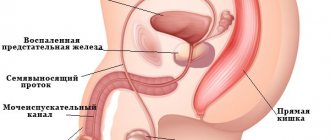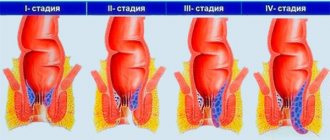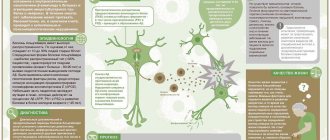Viral meningitis is an acute inflammatory disease that primarily affects the soft membrane of the brain. The main risk group is children under 10 years of age. But the disease can also affect young people under 30 years of age. The disease can be either independent or a consequence of previously suffered severe infectious diseases.
Online consultation on the disease “Viral meningitis”. Ask a question to the specialists for free: Infectious disease specialist, Neurologist.
- Etiology
- Methods of infection
- General symptoms
- Diagnostics
- Treatment
- Possible complications
- Prevention
Causes of meningitis
Viral meningitis is characterized not only by its primary appearance - the direct penetration of pathogenic microorganisms from the outside into the membranes of the brain, but also by a secondary complication - after an infection has already been suffered. This happens especially often in people whose protective barriers are significantly weakened - for example, after severe pneumonia, against the background of HIV infection.
Meningitis is transmitted from one person to another both through direct close contact - through everyday life, and through airborne droplets - when staying in the same room with poor air conditioning. Less commonly, infection occurs from a sick mother to a child, as well as through blood-sucking insects.
Later, viral agents travel through the blood, lymph or cerebrospinal fluid directly to the membranes of the brain. The main causative agents of meningitis: enteroviruses, adenoviruses, herpes simplex virus, mumps virus, HIV infection. The peak of infection occurs at the end of winter, the beginning of spring, as well as the summer months, when mumps viruses and enteroviruses are especially active.
Etiology and pathogenesis
Viral meningitis is an infectious disease caused by the penetration of pathogenic agents into the membranes of the brain. Viruses enter the soft shell in one of three ways:
- hematogenously - through blood vessels;
- lymphogenous - through the lymph flow;
- perineural route - entry of a viral microorganism from the nasopharynx cavity along the branches of the olfactory nerve.
How is the virus transmitted? Infection occurs through airborne droplets or contact (sexual, household contact) methods. The leading determining factor is the permeability of the blood-brain barrier, which allows viral agents to easily penetrate brain structures.
Predisposing factors are:
- closed or open craniocerebral injuries;
- insolation – excessive exposure to sunlight;
- overwork;
- dieting, poor nutrition, fasting;
- previous viral diseases that reduce general and local reactivity.
The main culprits of viral forms of meningitis are human enteroviruses . These microorganisms are resistant to acidic environments, ethanol, and traditional disinfectants and detergents. Enteroviruses remain viable outside the host for several days under standard climatic conditions. Most often, enterovirus infection is caused by ECHO viruses (enteric cytopathogenic humanorphan viruses) or Coxsackie viruses. These members of the enterovirus family are highly invasive, which causes their rapid spread. The habitat of Coxsackie viruses is the human digestive tract. They spread from an infected subject to a healthy person through insufficiently treated hands and through contact with contaminated surfaces.
Viral types of meningitis can be initiated by other pathogens, including:
- paramyxoviruses (Paramyxoviridae);
- Epstein-Barr virus (Human gammaherpesvirus 4);
- arenaviruses (Arenaviridae);
- cytomegalovirus (Human betaherpesvirus 5);
- adenoviruses (Adenoviridae);
- togaviruses (Togaviridae);
- bunyaviruses (Bunyavirales).
The incidence of serous viral meningitis increases significantly in the summer.
Classification of meningitis
Correct and timely diagnosis of viral meningitis is half the success in the fight against the disease. The classification of infectious brain lesions is intended to facilitate the work of specialists:
According to the flow form:
- primary meningitis - develops independently, since viral agents immediately penetrate the membranes of the brain and provoke inflammation in them;
- secondary meningitis - viral microorganisms move to the brain from another source of infection through the blood, lymph or cerebrospinal fluid.
By time of appearance:
- acute - symptoms are observed by the end of the first - beginning of the second day from the moment of infection;
- subacute - signs of viral brain damage become characteristic by the end of the first week after infection;
- chronic - doctors talk about a similar variant of meningitis when it is detected late.
Children are at risk for serous meningitis, since their protective barriers have not yet had time to fully form and it is easier for viral agents to penetrate the membranes of the brain. For adults, the bacterial nature of meningitis is more typical.
Diagnosis of meningitis
Along with neurological symptoms, laboratory examination methods are used to confirm the diagnosis:
- A lumbar puncture is performed to examine the cerebrospinal fluid. With a viral etiology of the disease, the cerebrospinal fluid contains an increased number of lymphocytes and protein against a background of normal glucose content. The absence of virus in fluid smears is an indirect symptom of serous meningitis.
- Using the polymerase chain reaction (PCR) method, the genus and class of the virus are detected in the cerebrospinal fluid based on RNA. PCR detects Coxsackie virus, ECHO and other enteroviruses, as well as the causative agent of polio and herpes simplex virus DNA. This method is important for differential diagnosis with specific meningitis.
- Enterovirus can be isolated by culture from other biological material - feces, blood or nasopharyngeal swab. Although enterovirus is isolated from feces for 2 weeks, during an outbreak of infection the presence of the virus may be a sign of previous infection or bacterial carriage.
- A general blood test determines leukocytosis.
- A biochemical blood test reveals hypergammaglobulinemia (increased content of the globulin fraction of protein).
The main method for diagnosing viral meningitis is the study of cerebrospinal fluid (CSF).
During puncture, cerebrospinal fluid flows out under pressure, after which the patient feels relief. Lumbar puncture reduces headaches.
Early symptoms
In most cases, viral meningitis is characterized by an earlier onset - the incubation period does not exceed 2-4 days. An inflammatory process in the meninges will be indicated by:
- a sharp jump in temperature - rising to 38.5–40 degrees;
- headache – intense, unbearable, not relieved by taking standard analgesics;
- numbness of the muscles in the area of the back of the head and neck is a specific symptom when swelling of the meninges provokes difficulty in the outflow of lymph and its accumulation does not allow turning/tilting the head;
- appetite – sharply reduced, up to its complete absence;
- the urge to feel sick and vomit – appear frequently, but do not bring relief to the patient;
- general weakness;
- malaise - it is literally difficult for a person to get out of bed and carry out hygiene measures.
Sometimes, among the initial symptoms of meningitis, a rash is observed - small pink spots may spread across the surface of the skin of the head and upper body, which disappear when pressed.
If treatment for viral meningitis is started at this stage, then severe consequences can be avoided. The person recovers completely without any damage to physical/intellectual activity.
Causative agents of viral meningitis
Viral meningitis develops when viruses penetrate the meninges. The disease can be primary (affect only the brain) or secondary (complication of the underlying disease). As a rule, secondary meningitis occurs. The majority, about 80-90%, of inflammation of a viral nature is provoked by enteroviral infections - Coxsackie virus and ECHO (Enteric Citopathogenic Human Orphan). Previously, polioviruses were another significant cause of brain damage, but with the beginning of mass vaccination against polio, this pathogen practically disappeared.
Among other possible causes of the development of damage to the meninges, doctors identify the following:
- Mumps virus.
- Epstein-Barr virus.
- Adenovirus.
- Cytomegalovirus.
- Herpesvirus.
- Influenza viruses.
- Rubella virus.
The main symptoms of meningitis
An increase in intracranial pressure parameters due to inflammatory processes in the meninges will contribute to the fact that the symptoms of viral meningitis become more pronounced every hour if complex treatment is delayed.
The symptoms of viral meningitis become clear and the diagnosis does not raise doubts among doctors when:
- pain in different areas of the head, but more pronounced in the back of the head and neck - intense, crushing, exhausting, lasting throughout the day;
- temperature jumps to significant figures - up to 40 degrees, for several days, practically does not decrease;
- sensitivity to light, sounds, touches appears - hyperesthesia;
- dizziness - persistent, intensifies with changes in body position;
- impaired consciousness - up to coma;
- vomiting - attacks, but does not improve well-being;
- diarrhea - several times a day, but without additional impurities of blood or pus;
- pressure in the eye area - due to high intracranial pressure;
- attachment of the inflammatory process in the nearest groups of lymph nodes.
Specialists will check for the presence of special symptoms that indicate meningitis - for example, due to muscle tension, it is not possible to fully straighten your knees, or tapping on the zygomatic arch provokes involuntary contraction of the facial muscles.
Nonspecific manifestations of meningitis include cough and runny nose in the early stages of infection, high blood pressure and convulsions in the later stages of the disease, as well as deterioration in visual and auditory function.
Prevention
Viral meningitis can be effectively prevented by observing hygiene measures, refusing to swim in a body of water, and using boiled or bottled water for drinking. To prevent infectious diseases in Russia, according to the calendar, mandatory vaccination of children against polio, measles and mumps is carried out. Vaccinations simultaneously protect children from complications of infections in the form of viral meningitis. Annual seasonal influenza vaccination is a means of preventing infection and complications of the disease.
The best method of preventing bacterial meningitis is vaccination. According to WHO guidelines, all people from 1 to 29 years of age in the African meningitis belt are immunized against meningococcus with the MenA vaccine.
As a result, we recall that the causative agent of viral meningitis is often identified as enterovirus. If neurological symptoms are positive, confirmation is made by lumbar puncture. The course and prognosis of the infection is favorable. To prevent the disease, it is recommended to follow hygiene rules and make mandatory vaccinations for children against common infections according to the Russian Calendar. Vaccination simultaneously prevents complications of viral meningitis infections.
Features of meningitis in children
In children, the course of viral meningitis may vary depending on the age of the child. Thus, in newborns, swelling of the membranes of the brain provokes severe disruptions in the central nervous system - disturbances of consciousness, bulging of the large fontanel, high temperatures.
In children from one to three years of age, the symptoms are similar to the course of polio - seizures of convulsive hyperactivity and paralysis of the limbs. Younger schoolchildren more often experience severe headaches, vomiting, skin rashes and fever with hypertensive crises.
After 6 years, children suffer more from the symptoms of infection with enteroviruses - nausea, vomiting, as well as abdominal pain and diarrhea. In adolescence, clinical manifestations are comparable to those in people 25–45 years old - tension in the muscles of the neck, high temperature, hallucinations, high temperatures and pressure.
However, children often experience complications of meningitis:
- inflammation of the heart muscle - myocarditis;
- decreased intellectual capabilities;
- paralysis/paresis of varying severity - the inability to fully move and care for oneself.
In addition to all of the above, against the background of meningitis, general infectious symptoms appear - increased capriciousness of babies, refusal to eat, tearfulness, sleep disturbance, general weakness.
Possible complications
Any disease, if not treated promptly, can have serious consequences. Serous and viral meningitis is no exception.
In children of primary school age, the following consequences are possible:
- disturbances in the functioning of the central and nervous system;
- developmental problems;
- psychological disorders.
As for complications in adults, the following consequences are possible:
- disturbances in brain function;
- damage to the peripheral and central nervous system.
In some clinical cases, a person who has had viral or serous meningitis may experience headaches and unstable blood pressure for a long time.
All these consequences can be avoided if you seek medical help promptly and treat all viral diseases to the end. Therefore, at the first symptoms you should seek competent medical help.
Diagnostics
In order to establish the true nature of viral meningitis - the penetration of agents of a particular infection, specialists will prescribe modern laboratory research methods:
- analysis of cerebrospinal fluid - it is taken directly from the spinal canal when pierced with a special needle;
- isolation of the causative agent of meningitis - since the amount of viral agents directly in the cerebrospinal fluid is insignificant, they are detected in other biological materials, for example, blood, feces;
- blood tests - general and biochemical, to assess the general health of the patient.
In case of atypical meningitis, electromyography, electroencephalography, as well as computed tomography or magnetic resonance imaging of the brain are additionally recommended.
A highly qualified specialist makes a preliminary diagnosis based on the patient’s complaints, a thorough examination of him, especially his neurological status, and also taking into account information about the possible viral origin of the disease - contact with another sick person. While all of the above laboratory and instrumental research methods will confirm the diagnosis.
Methods of infection
Viruses of this type are transmitted by airborne droplets: sneezing and coughing. The virus can also be transmitted through close contact with an already sick person. In more rare clinical cases, the disease can be transmitted from mother to child placentally.
The most dangerous period for infection is summer and early autumn. This is due to the fact that viral organisms of this type reproduce well in a warm environment.
The main carrier of the virus is an already infected person. Therefore, after visiting public places, you should wash your hands well with soap and rinse your nose and throat with saline solution.
Treatment tactics
In most cases of diagnosed viral meningitis, the course of the disease and the person’s condition allows treatment to be carried out on an outpatient basis. Basic recommendations from doctors:
- long bed rest;
- absolute physical and psychological peace;
- staying in a darkened room with a temperature of 20–22 degrees;
- good nutrition - easily digestible, fortified meals;
- compliance with the drinking regime - drink purified water without gases, juices, green tea.
The main treatment for viral meningitis is to suppress the activity of viral microorganisms. For this purpose, modern antiviral drugs are prescribed - intravenous administration of immunoglobulins, oral tablets, for example, Acyclovir.
Otherwise, treatment measures are carried out according to the existing symptoms:
- at high temperatures - antipyretics, for example, based on Paracetamol or Ibuprofen;
- for severe pain - analgesics both orally and parenterally (not through the gastrointestinal tract);
- to increase protective forces - vitamin complexes.
In the absence of complications, the patient’s well-being improves quickly – as soon as the intracranial pressure decreases. However, he must remain under medical supervision for several more weeks to exclude long-term effects on the central nervous system.
Treatment
The course of treatment and its duration are prescribed only by the attending physician after a comprehensive examination. In case of viral meningitis, hospitalization of the patient is required.
Treatment of viral meningitis includes only drug therapy. But, as with serous meningitis, in more severe cases the patient may undergo a cerebrospinal fluid puncture. Immediately after the drainage of excess cerebrospinal fluid, the patient feels much better.
Drug therapy includes taking the following drugs:
- interferon;
- immunoglobulins;
- acyclovir;
- antiviral drugs;
- for general strengthening of the immune system;
- corticosteroids;
- analgesics;
- drugs to block seizures.
The frequency of administration and dosage are prescribed only by the attending physician. If it is impossible to take medications orally, they can be administered intravenously.
The drug "Interferon"
In addition to taking medications, the patient must strictly adhere to bed rest and eat properly. There is no special diet for viral meningitis, as for serous meningitis. But the patient’s food must be rich in proteins and have all the necessary vitamins. It goes without saying that the consumption of heavy food and alcohol is completely excluded.
Upon completion of drug therapy, the patient is required to undergo a rehabilitation course. It is optimal to spend this period (one to two months) in a special sanatorium or dispensary.
If treatment is started in a timely manner, severe consequences can be avoided. On average, the course of treatment lasts from 10 to 15 days.
Prevention and prognosis in the treatment of meningitis
Measures to prevent infection with viral meningitis always include timely vaccination of the population. Only high protective barriers against the most common infections - measles, mumps, as well as rubella and herpes - will help prevent the disease.
There are also nonspecific measures to prevent meningitis. Experts recommend:
- harden the body;
- Healthy food;
- have less contact with sick people - those who cough, have a runny nose, sore throat;
- give up bad habits – consumption of tobacco and alcohol products;
- get enough sleep - good sleep always strengthens the immune system;
- carry out seasonal prevention of viral diseases - eat more garlic, onions, dress for the weather.
The prognosis for most meningitis of a viral nature is favorable - the person recovers without any serious consequences for intellectual activity. Rarely, residual manifestations may be observed in the form of increased weakness and fatigue, sharp headaches. They are gradually eliminated by following the doctor’s recommendations - get more rest, eat fruits and vitamins. Meningitis can be defeated if maximum effort is made by both the doctor and the patient himself.
Prevention of meningitis
Due to the fact that this form of meningitis is viral in nature, its formation can be prevented and serious consequences can be avoided.
The main measures to prevent viral or serous meningitis are that any infectious or viral diseases must be treated promptly and completely.
In addition, the following rules should be applied in practice:
- compliance with personal hygiene rules;
- regular wet cleaning and ventilation of the living space;
- washing hands immediately after visiting public places;
- using only your own hygiene items;
- strengthening your immune system;
- moderate physical activity and a balanced diet.
The application of such rules in practice will help to avoid not only serous or viral meningitis, but also many other viral diseases.
Who is at risk?
Of course, there are some risk groups. Since the disease develops against the background of infection, the state of the human immune system is important in this case. That is why serous meningitis is most often diagnosed in preschool children, since the protective systems of their body are in the process of formation.
In adults, such inflammation is usually associated with a severe weakening of the immune system. Risk factors include the presence of various chronic diseases that gradually deplete the body. Serous meningitis is often diagnosed in patients with cancer and various immunodeficiencies. In addition, constant stress, poor nutrition, sudden hypothermia and vitamin deficiency also increase the likelihood of developing this disease.
Risk factors include non-compliance with sanitary requirements, as well as poor living conditions. After all, rats are carriers of some viruses. By the way, in most cases, outbreaks of this disease are recorded in spring and summer.
How to treat?
Treatment is carried out strictly under hospitalization conditions in the intensive care unit in infectious diseases clinics. Prescriptions are made by an infectious disease specialist. There is no treatment at home due to the high mortality rate of the disease.
Drug therapy for bacterial meningitis:
- Antibacterial drugs - penicillins and cephalosporin antibiotics (Cefazolin, Ceftriaxone, Cefuroxime).
- To reduce swelling and ICP - diuretics (Furosemide, Mannitol, Lasix, Diacarb).
- Anti-inflammatory and decongestants - Dexamethasone, Prednisolone, Diclofenac, Nimesil, Ibufen.
Surgical operations - with the development of purulent processes in the brain (abscess, empyema).
Complications and consequences of the disease
After the disease, certain pathologies are formed, which are temporary or permanent. The degree of their severity depends on the start of treatment, the drugs used, their effectiveness and the body’s response to the action of antibiotics. In patients after a bacterial disease, they find:
- acute renal failure due to tissue necrosis;
- deafness formed due to swelling of the membranes;
- joint diseases - bone and connective tissue suffers;
- —epilepsy— – most often resolves after physiotherapeutic procedures;
- delayed mental development, memory and speech in children;
- organic psychosyndrome - complete apathy or the opposite state of increased excitability. There are frequent manifestations of aggression or passivity, sudden mood swings.
Bacterial meningitis is a disease that can be cured without serious consequences for the body. The main thing is to notice the symptoms in time, consult a doctor and undergo therapy in a hospital setting, and not rely on the help of symptomatic medications or traditional recipes.
Causes of the disease
The main reasons for the development of a bacterial inflammatory process are associated with the penetration of pathogenic and infectious pathogens into the human body. The most common bacteria that provoke the development of pathology of the brain and spinal cord are:
- aggressive species of bacteria of the streptococcus family;
- meningococci;
- hemophilus influenzae;
- coli;
- Klebsiella;
- listeria;
- spirochetes;
- enterobacteria.
These bacteria are considered opportunistic pathogens - what does this mean? Such microorganisms may be present in the human body, but under favorable conditions they become pathogenic.
Acute bacterial meningitis is most often diagnosed in young children, but can also occur in adults. What factors can cause the disease in an adult? Inflammation can be caused by chronic alcoholism, previous splenectomy, and inflammatory diseases of the ENT organs.
In addition, meningitis is transmitted as a result of unsuccessful surgery, during which pathogens of the disease and serious traumatic brain injuries enter the human body. The cause of the disease can also be surgery on the gastrointestinal tract, amputation of a body part, tuberculosis, syphilis, or HIV infection.
Main symptoms
Signs of the disease appear after 2-14 days. This is the time it takes for microorganisms to spread throughout the membranes of the brain and cause inflammation.
The first sign is increased body temperature. Also accompanying symptoms are chills, nausea and vomiting, nasal congestion, inflammation of the mucous membranes of the throat and nose. In some cases, there is increased tooth sensitivity.
It is difficult to determine the presence of bacterial meningitis based on the first symptoms, since the pathology is similar to the common cold.
But as the pathological process spreads, the following symptoms arise:
- Throwing the head back. The cause is increased tone of the neck muscle tissue.
- When you tilt your head, nausea appears, which develops into vomiting and pain.
- Inability to straighten a leg bent at the knee.
- When you tilt your head down, bend your lower limbs and pull them toward your stomach.
- When pressing on the pubis, the legs bend at the hip joint.
The appearance of headaches, general weakness, and constant fatigue is also noted. Patients experience impairment of certain reflexes, indicating damage to the central nervous system.
Upon examination, a rash in the form of dots or stars appears on the skin. Often the spots are quite large in size and can merge with each other.
In severe cases of bacterial meningitis, when the pathological process affects large areas of the membranes of the brain, coma may occur, convulsive seizures, shortness of breath and delirium may occur. When the symptoms lose intensity, pulmonary edema occurs.
Basic preventive measures
As you can see, serous meningitis is a rather serious disease, to which children are most susceptible. Therefore, today many parents are interested in questions about whether there are effective precautions. Preventive measures can be divided into two groups - medicinal and regime-based.
As already mentioned, in most cases it is viruses that cause serous meningitis. Symptoms in children often occur against the background of diseases such as measles, rubella, etc. Drug prevention includes mandatory standard vaccinations against infectious diseases. In addition, doctors recommend taking multivitamin and immunomodulatory medications from time to time, which reduce the likelihood of developing the disease.
Naturally, these are not all measures that can prevent serous meningitis. Prevention includes other equally important aspects. In particular, it is extremely important to maintain the normal state of the immune system, which is facilitated by a healthy diet, physical activity, hardening, lack of stress, etc.
On the other hand, do not forget about hygiene standards. In particular, you should not eat unwashed fruits and vegetables, or drink contaminated water. Personal hygiene is also extremely important. And, of course, the first signs of serous meningitis are a serious reason to immediately see a doctor. Be attentive to your health and the health of your loved ones!
Clinic of selected forms of serous meningitis
The main signs of the disease were discussed above. But the disease can occur in several forms. To correctly prescribe therapy, the specialist must find out what type of meningitis. It can be preliminarily determined by additional symptoms.
Acute lymphocytic choriomeningitis
Serous meningitis (symptoms in children when infected with lymphocytic choriomeningitis and the course of the disease in an acute form are pronounced) in this case develops due to mice. They excrete the infection along with mucus, urine and feces.
The pathogen can be found in food, water and objects.
When a child becomes infected, not only inflammation of the membranes of the brain occurs, but the functioning of the vessels of the cerebral ventricles is also disrupted. The disease is similar to the flu. The difference is a positive reaction to additional tests (Lesage, Kernig).
The disease usually occurs in 2 stages. Initially, flu symptoms appear, then the condition worsens greatly, and all the signs of meningitis appear. If you go to the hospital in a timely manner, treatment has a favorable outcome.
Tuberculous meningitis
Tuberculous meningitis develops as a result of Koch's bacillus entering the body. Most often (more than 75%) this is a complication after tuberculosis of the lungs, kidneys, and genitals. The pathogen enters the brain through blood vessels. The danger of the disease is that with anti-tuberculosis therapy, meningitis can become chronic.
The severity of symptoms appears 14-21 days after the onset of the disease. To the main symptoms is added a dysfunction of the optic nerve (decreased vision, strabismus, pain in the eyes). If proper treatment is not started at this stage within a week, death is possible.
Fungal meningitis in AIDS
Serous meningitis caused by a fungus, in the presence of AIDS in a patient, often proceeds sluggishly and with virtually no symptoms.
In children, the main symptoms are lethargy, sleepiness, and tolerable headaches.
There are often no obvious symptoms of meningitis. The pediatrician can make an accurate diagnosis after a complete examination.
Prognosis and complications of serous meningitis
With timely detection of the disease and proper treatment, the disease proceeds without complications. After recovery, the child returns to a full life. But if the disease was hidden or was not immediately recognized, then the consequences of meningitis may remain. The most dangerous outcome is death. It most often occurs when tuberculosis is not treated in a timely manner.
Complications after the disease:
- paroxysmal headaches;
- sleep disturbance, including insomnia;
- impaired perception of new information;
- deterioration of vision and hearing;
- delays in psychological development;
- epileptic seizures;
- lack of coordination and involuntary contraction of muscle groups.
If all conditions are met during the rehabilitation period, complications may stop 5-6 years after recovery. To do this, you additionally need to be observed by specialists and carry out the necessary therapeutic games and physical exercises.
Serous meningitis is most dangerous in children under 1 year of age. But since the symptoms are pronounced, it is impossible to miss the disease. Parents need to monitor the condition of their children after serious illnesses. If you suspect meningitis, call emergency services.
Author of the article: Kotlyachkova Svetlana
Article design: Oleg Lozinsky
Symptoms and signs
At the end of the incubation period, the duration of which depends on the type of pathogenic bacterium and generally ranges from seven to ten days, the first symptoms of meningitis appear, which manifest themselves clearly.
The first sign of inflammation that has spread to the meninges is an increase in temperature, first sharply to 38 degrees, and then rises higher and higher.
The patient begins to experience severe chills and experience all the delights of a very strong inflammatory process.
Then more specific symptoms are added that can appear along with the temperature: severe headaches, tormenting nausea, vomiting, as well as hyperesthesia - increased sensitivity of the sensory organs to irritants, which causes considerable discomfort.
Possible stiffness of the neck muscles (increased tone), Kerning and Brudzinski, Babinski and Oppenham symptoms, which are diagnostic methods (see below).
Sometimes patients experience hemorrhagic exanthema or, in other words, a rash, which, due to the pattern of dislocation, can occupy the entire body or certain areas, looks like a spot.
If the brain has undergone acute edema and swelling, then symptoms may be added by clinical-tonic convulsions (rapid muscle contractions that occur during epilepsy) and shortness of breath.
In severe form, the patient suffers from psychoneurological manifestations in the form of stupor, agitation, which can occur either individually or in turn, as well as delirium.
As the disease progresses, meningeal symptoms disappear or fade away, and instead symptoms of damage to the cranial nerves appear in the form of focal disorders, changes in reflexes, paralysis or agitation. Signs of encephalitis may be observed.
The symptoms of infants differ from the signs of meningitis in adults. In infants, symptoms are represented by swelling of the fontanelles with their tension.
With bacterial meningitis, children do not have specific meningeal signs, since due to their young age they cannot complain of headaches, changes in worldview or hallucinations, but they experience symptoms of severe inflammation in the form of fever, impaired reflexes, sometimes jaundice, refusal to eat , fountain regurgitation, indigestion, extreme excitement or, conversely, stupor. Judging by the behavior and appearance of the child, it immediately becomes clear that he is sick and an urgent examination is necessary, which reveals bacterial meningitis.
Children of a little more intelligent age may fall into lethargy or show signs of dullness.
What is the difference between viral and bacterial meningitis?
Based on etiology, meningitis is classified as viral, bacterial and fungal. Viral meningitis is acute, but less aggressive than bacterial meningitis.
This infection is more common in older people. The causative agents of bacterial meningitis are meningococcus, pneumococcus Haemophilus influenzae. One of the dangerous forms of the disease is meningococcal meningitis.
Acute bacterial meningitis is a fulminant, often fatal purulent infection of the meninges.
The incubation period of bacterial meningitis is from 2 to 12 days. The next 1–3 days are characterized by symptoms of nasopharyngitis with an increase in temperature of 38.0 °C. The appearance of the pathogen in the bloodstream is the beginning of the acute period of the disease. Symptoms of meningococcal, as well as viral meningitis, are fever up to 40.0 ° C, tension in the neck muscles, headaches accompanied by vomiting.
The course of bacterial meningitis is much more severe than viral meningitis. Bacterial toxins lead to the development of infectious-toxic shock. With bacterial etiology, the process spreads from the soft membranes to the brain tissue, complicated by encephalitis, which leads to the development of seizures. A rash in the form of petechiae appears on the skin. Increased intracranial pressure is dangerous due to wedging into the foramen magnum with a fatal outcome.
Diagnosis of the disease in the acute period is based on the following methods:
- During bacteriological examination in all age groups, the pathogen is found in the cerebrospinal fluid in 80% of cases, and in the blood in 40% of cases.
- The cerebrospinal fluid is cloudy and leaks under pressure. Neutrophilic cytosis and an increased amount of protein are detected in the cerebrospinal fluid.
- Bacteria are detected in the cerebrospinal fluid or blood by culture and antibiotic sensitivity testing.
- Detection of bacteria by PCR.
- In the general blood test, leukocytosis is up to 20,000.
Etiology
In more than 80% of cases, the disease is caused by the microorganisms N. Meningitidis (meningococci), H. Influenzae (Haemophilus influenzae) or S. Pneumoniae (pneumococci) and Staphylococcus (staphylococci).
Bacterial meningitis is most often provoked by staphylococci, which have quite a few varieties and, in addition to it, are the main causative agents of colds, pneumonia and pleurisy.
Meningococci are transmitted mainly by airborne droplets and often affect the human nasopharynx and mucous membranes of the respiratory tract, spreading to the membranes of the brain if left untreated. The main route of transmission of this infection is from person to person. They can cause both serous and purulent meningitis.
Haemophilus influenzae or influenza bacterium is also transmitted by airborne droplets and contact and is the causative agent of colds, causing pneumonia, otitis, arthritis and other diseases in a purulent form. The mortality rate in cases of meningitis with this infection is 30%.
Pneumococci provoke diseases of the same group as the first two pathogens and are mainly transmitted by airborne droplets and can cause a purulent form of the disease.
Cases of hospital-acquired bacterial meningitis in children are often represented by Flavobacterium meningosepticum, a hospital-acquired infection transmitted directly through antiseptic solutions.
The causative agents of the bacterial form of inflammation of the membranes of the brain or spinal cord include chlamydia, which has some features of the life cycle in the form of reticular bodies. Chlamydial meningitis occurs similarly to viral meningitis, and therefore, due to its atypical course, it is often classified as a separate group. In its pure form, chlamydia causes meningitis of the serous type, however, bacterial flora is often added to them, after which the disease becomes purulent. Chlamydia is transmitted mainly sexually or from mother to child, occasionally through household contact, and in addition to meningitis, it causes inflammatory diseases primarily of the genitourinary system and can affect any organs.
Rare forms of meningitis can be caused by a variety of microorganisms that only exist and can cause inflammation of the internal organs of a person. Thus, there have been cases of disease caused by simple amoebas and even by the intestine’s own bacteria. Such forms of microorganisms cause bacterial meningitis exclusively in cases of immunodeficiency conditions.
Etiology of the disease
Acute serous meningitis in most cases occurs against the background of enterovirus infection, Coxsackie. Rarely, infectious mononucleosis, mumps, influenza, and measles may be the cause. Since these diseases most often occur in children, meningitis usually appears at this age. It is important to consider that a child can easily become infected with viral diseases from other children (in kindergarten, school). Therefore, doctors recommend getting vaccinated on time.
The bacterial form of the disease is associated with the presence of syphilis and tuberculosis. People suffering from such diseases often face various complications . In such cases, a purulent lesion occurs, caused by meningococci. Serous meningitis is one of them.
Children are at risk because they often suffer from enterovirus infections. Against this background, serous meningitis develops successfully. Initially, cerebral edema and impaired outflow of cerebrospinal fluid occur. In this regard, intracranial pressure increases.
It is worth noting that this form of the disease is not as dangerous as the others. Unlike bacterial and purulent lesions, it does not have severe complications. The incubation period lasts 2-4 days.










